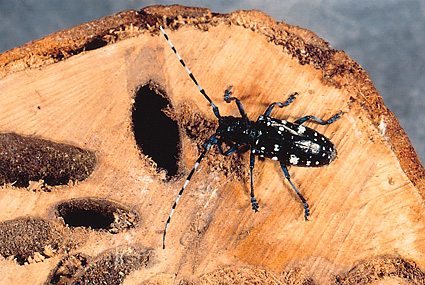Asian long-horned beetle is an insect that feeds on trees. This beetle kills many kinds of hardwood trees, such as elm, maple, poplar, and willow. It is native to Asia but has spread to North America, where it is considered a pest. The Asian long-horned beetle is also called the starry sky beetle.
An adult Asian long-horned beetle grows about 1 to 11/4 inches (2.5 to 3 centimeters) long. It has a shiny, black, bullet-shaped body covered with white spots. Horn-shaped antennae (feelers) stick out from the beetle’s head. White rings appear on these black antennae, which are longer than the insect’s body.

Adult beetles usually mate during the late summer months. The female chews a hole in the base of a tree after mating. She lays her eggs in the hole and seals it with a cementlike substance. Once the eggs hatch, the larvae (young) feed on the wood. The larvae chew deeper into the tree as they grow, creating long, winding tunnels. These tunnels damage the tree’s circulation system, which carries water and other nutrients to and from the leaves. This damage eventually kills the tree. Once the larvae become adults, they chew large, circular holes through the bark and leave the tree.
The most effective way of destroying the beetle is to cut down infected trees and grind the wood into sawdust. Pesticides do not kill the beetle because the larvae tunnel too deep within a tree to be reached by the chemicals.
Asian long-horned beetles first appeared in North American trees during the mid-1990’s. Many traveled from Asia to North America in wooden crates used to ship goods.
